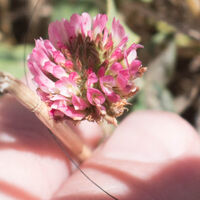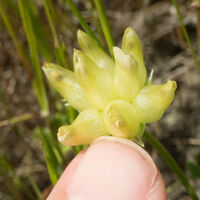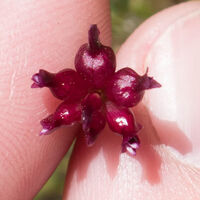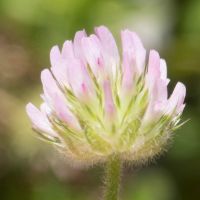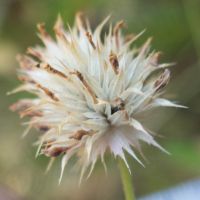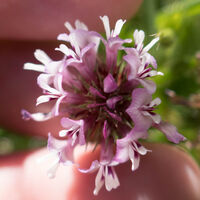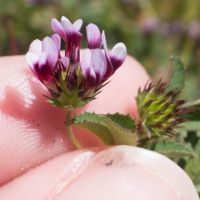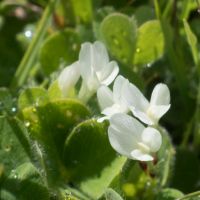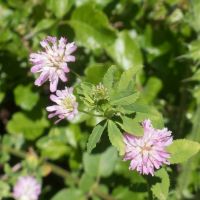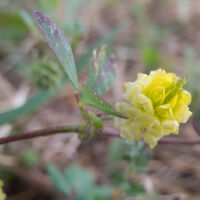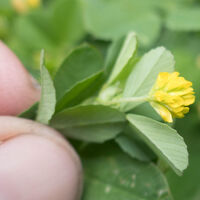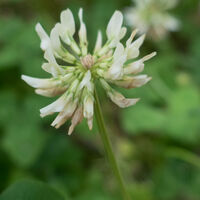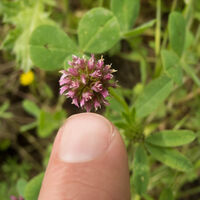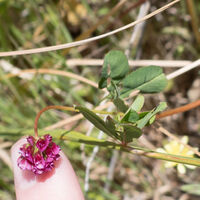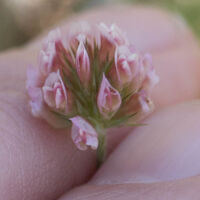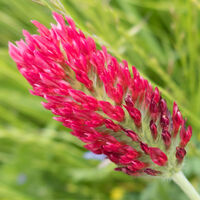clovers
genus Trifolium
Member of
legume family (family Fabaceae)
dicots (class Magnoliopsida)
flowering plants (subphylum Angiospermae)
Except for historical records that I'm ignoring, there are no other wild species of this genus in the bay area.
Much depends on the bracts (involucre), so always photograph the clover head from beneath, and measure the length of the bracts. The involucre is always snuggled up against the inflorescence, and depending on its size it may or may not hide the pedicels at the base of the inflorescence.
There are generally 5 sepals, generally fused into a calyx for each flower. There are also generally 5 petals, which may be free, fused, or only the lower 2 ± fused into a keel. It may be useful to pluck a calyx/corolla combination to get a closer look at the calyx.
Camera angles:
- close look at top/side of inflorescence with scale
- close look at bottom of inflorescence with scale
- leaflets with scale (not the reduced leaflets directly below the inflorescence)
- peduncle with scale
Key features:
- bracts shape (especially if fused) under inflorescence
- calyx lobes plumose or not
- corolla color
- lengths of bracts, sepals (calyx), petals (corolla), leaflets, leaf stipules, peduncle, and consider pulling off a corolla for the pedicel length
- leaflets palmate or pinnate
- leaflet shape
- various parts hairy or glabrous
Involucre bracts generally free, generally > 1 mm
Inflorescence not sessile above 1–2 leaves
Banner soon inflated in fruit
Trifolium fucatum
- glabrous
- Leaflets: 3, palmate, 1–2.5 cm, elliptic to ± round, ± entire to toothed
- Bracts: ± free to ½ fused
- Inflorescence: head-like, 5–many-flowered; flowers quickly spreading or reflexed
- Calyx: 4–7 mm, glabrous, longer lobes bristle-like, generally branched
- Corolla: 10–20 mm, dull white or ± yellow, purple-tipped (or not?), banner inflated in fruit
- see also pale sack clover (Trifolium depauperatum var. amplectens)
Trifolium depauperatum
- glabrous
- Leaflets: 3, palmate, 0.5–2 cm, narrowly oblong to obovate, entire or toothed, occasionally lobed, tip generally truncate
- Bracts: fused, vestigial, ring-like in ssp. depauperatum; ± free in variants
- involucre bracts < 1 mm, fused at base
- Inflorescence: head-like, 0.5–1 cm wide, 3–many-flowered
- Corolla: 4.5–9 mm, pink-purple (but CalPhotos also shows cream w/ purple above), white-tipped, banner inflated in fruit
Involucre bracts generally fused, generally > 1 mm, generally forming cup or bowl about base of inflorescence
Inflorescence not sessile above 1–2 leaves
Calyx and corolla not inflated in fruit
Involucre cup- or bowl-shaped, when pressed generally partly hiding flowers
Trifolium barbigerum
- calyx lobes > ½ tube, bristle-tipped
- calyx lobes, involucre lobes, or both toothed, cut, or branched
- plant hairs 0 or finely wavy or not
- calyx lobes entire, bristle at tip 3–4 mm, plumose (or lower lobes divided to near base into 2–3 bristles, each 3–4 mm, generally plumose)
- involucre generally puberulent
- banner inflated below, persistent as twisted beak above
- corolla 5–10 mm, ≤ (rarely ± >) calyx
- stalk-like fruit base < 1 mm
- inflorescence generally bristly from calyx lobes
Trifolium grayi
- calyx lobes > ½ tube, bristle-tipped
- calyx lobes, involucre lobes, or both toothed, cut, or branched
- plant hairs 0 or finely wavy or not
- calyx lobes entire, bristle at tip 3–4 mm, plumose (or lower lobes divided to near base into 2–3 bristles, each 3–4 mm, generally plumose)
- involucre generally puberulent
- banner inflated below, persistent as twisted beak above
- corolla 8–16 mm, > calyx
- stalk-like fruit base 1–3 mm
- inflorescence not bristly
Involucre wheel-shaped, when pressed hiding only bases of flowers
Trifolium obtusiflorum
- calyx lobes ± ≤ tube, often toothed or shouldered below tapered tip
- calyx tube splitting between upper lobes
- flower 9–18 mm
- involucre > 3 mm, cut < ½ to base
- inflorescence generally 12–30 mm wide, often > 15-flowered
- calyx glandular-hairy or bumpy (occasionally in age glabrous), lobes generally entire
- leaflets sharply serrate, longer teeth ± 1 mm
- stem glandular-hairy, generally sticky
Trifolium willdenovii
- calyx lobes ± ≤ tube, often toothed or shouldered below tapered tip
- calyx tube splitting between upper lobes
- flower 9–18 mm
- involucre > 3 mm, cut < ½ to base
- inflorescence generally 12–30 mm wide, often > 15-flowered
- calyx glabrous, not bumpy, lobes entire or 3-toothed
- leaflets serrate, teeth < 1 mm
- glabrous all over
- Leaflets: 1–5 cm, linear to obovate, serrate, teeth < 1 mm
- Bracts: fused together; wheel-shaped, sharply lobed or dissected
- Inflorescence: head-like, 1.5–3 cm wide, generally lobed, many-flowered except on small plants
- Calyx: 6–10 mm, shiny
- Corolla: 8–15 mm, lavender to purple, tip generally white
Involucre bracts 0 or occasionally < 1 mm or forming a vestigial ring
Inflorescence occasionally ± sessile above 1–2 ± reduced leaves (stipules of which occasionally involucre-like)
Trifolium macrocephalum
- leaflets generally 7–9
- for all others in this box, leaflets 3
- inflorescence 3–5 cm wide
- very rare; Mt. Diablo
Trifolium dubium
- Leaflets: 3, pinnate, petioles of mid-leaves generally < leaflets
- inflorescence: head- to ± spike-like, 4–8 mm wide, 5–10(20)-flowered; flowers quickly reflexed
- corolla: 3.5–4 mm, bright yellow, brown in age, weak-striate
- looks similar to black medick (Medicago lupulina), but lesser hop trefoil has the following characteristics:
pedicels 1–6 mm, ± equal
flowers generally becoming reflexed
Trifolium ciliolatum
- ± glabrous
- Leaflets: 3, palmate, 1–3 cm, oblanceolate to obovate, serrate
- Bracts: inconspicuous, often in a ring at base of head
- Inflorescence: head-like, 7–20 mm wide, ovate or spheric; axis occasionally exserted; pedicels in age 3–6 mm; flowers soon reflexed
- Calyx: 5–6 mm, tube glabrous, lobes unequal, ciliate with short, flat bristles (or, through breakage, bristle bases)
- Corolla: ± ≥ calyx, pink to purple
pedicels < 2 mm
flowers becoming reflexed or not
Trifolium glomeratum
- ± glabrous
- Leaflets: 3, palmate, 5–12 mm, obovate
- Bracts: none or occasionally < 1 mm or forming a vestigial ring
- Inflorescence: sessile at end of stems or in succession of leaf axils, head-like, 7–10 mm wide, many-flowered; pedicels < 1 mm
- Calyx: 3–5 mm, lobes triangular
- for all others below, corolla generally > 5 mm
- Corolla: 4–6 mm, ± > calyx, pink [or white with little or no pink showing]
Trifolium cernuum
- inflorescence axillary only
- peduncles short at least on lower inflorescences, may be 0 above
- very rare
inflorescence ± sessile above a pair of reduced leaves, stipules, or both
Trifolium macraei
- inflorescence generally paired, ± sessile or occasionally 1 short-peduncled above (1)2 leaves
- [the inflorescences may be unequal in development]
- for all others in this section, the inflorescence is single above subtending leaves
Trifolium amoenum
- resembles tomcat clover, but the head is much denser with flowers
- hairy
- Leaflets: 3, palmate, widely obovate
- Bracts: unknown
- Inflorescence: head, ovate to spheric; sessile [CalPhotos does not consistently show this] above 1–2 ± reduced leaves (with 3 leaflets each)
- Calyx: 10–12 mm, slender, plumose
- Corolla: 12–16 mm, purple, tips white
- for all others in this section below, the corolla is one-colored, red-purple or pink
- rare
Trifolium hirtum
- calyx lobes densely to sparsely plumose, ≫ tube, lower one ± 1–1.5 × others
- hairy on stem, leaflet margins and stipules
- Leaflets: 3, palmate, 1–2.5 cm, obovate
- Bracts: none, but leaf stipules look like pale bracts with dark red veins
- Inflorescence: spheric, ~15–20 mm, many-flowered; sessile above 1–2 ± reduced leaves (with 3 leaflets each) with involucre-like stipules
- Calyx: 7–9 mm, bristle-like, densely plumose
- Corolla: 11–15 mm, generally pink
inflorescence peduncled, peduncle generally > 10 mm, generally > leaves
Trifolium albopurpureum
- corolla ≤ calyx
- calyx lobes > tube, plumose
- leaflets oblanceolate to obovate, length 1.2–3 × width
- corolla purple with white tips
- calyx 4–8 mm, lobes 3–6.5 mm
- resembles tomcat clover and rose clover
- hairy
- Leaflets: 3, palmate, 1–3 cm, oblanceolate to obovate
- Bracts: none
- Inflorescence: spike, 5–20 mm wide, ovate to short-cylindric
- Calyx: 4–8 mm, lobes 3–6.5 mm, > tube, tapered or bristle-like, plumose
- Corolla: 5–8 mm, ≤ calyx, purple and white
Trifolium angustifolium
- corolla ≤ calyx
- calyx lobes > tube, plumose
- leaflets linear to narrow, length 3–8 × width
- corolla pale pink
- corolla 10–12 mm, ± = calyx
- slightly hairy stem, long-hairy leaf stipules
- Leaflets: 3, palmate, 2–4.5 cm, linear to narrowly lanceolate
- Bracts: none
- Inflorescence: peduncled; spike, 1–5 cm, cylindric
- Calyx: 10–12 mm, lobes spreading, needle-like, plumose
- Corolla: 10–12 mm, ± = calyx, pale pink
Trifolium suffocatum
- not in Jepson
- very rare
22 observed taxons / 21 unobserved taxons / 2 keys
Locations: Months: For more details, use advanced search.
Chris’s observations: 227 (226 are research grade)
Taxon info: iNaturalist – Calflora – Jepson eFlora – FNA
Bay Area species: iNaturalist – Calflora
